Key findings
- 25.8 % of 2.37 million US queries we analyzed surfaced an AI Overview box
- Queries with 8+ words have a 57.3% chance of AI Overviews appearing in search results
- Industries like pets & animals, mental health, and personal finance are most impacted by AI Overviews
- Informational queries are most impacted by AI Overviews, with 39% of them producing AI Overviews
- Queries with “near me” see a 70% drop in AI Overviews appearing
- Queries using “Why” or “How” see the most appearances of AI Overviews
It’s talked about behind executives’ closed doors. Your colleagues whisper and wonder about what it means for the future. All ages, from young, new Internet users to experienced Googlers, are seeing it now.
Yup, it’s AI Overviews.
While many skeptics believed it was a phase that would fade out, it’s not true — AI Overviews is here to stay, and it’s only going to become more integral.
In March 2025, 25% of Google searches produced an AI Overview — that number is only expected to continue growing as Google leverages this feature more in search results. So, what does this mean for your SEO strategy?
To find out, we analyzed over 2.3 million keywords to get the answer to those questions. Discover the insights we uncovered and what it means for the future of your search strategy!
The long road home: Where do AI Overviews mainly appear?
One of the most important insights we gathered from this analysis is that AI Overviews tend to appear most often for queries that use 8+ words!
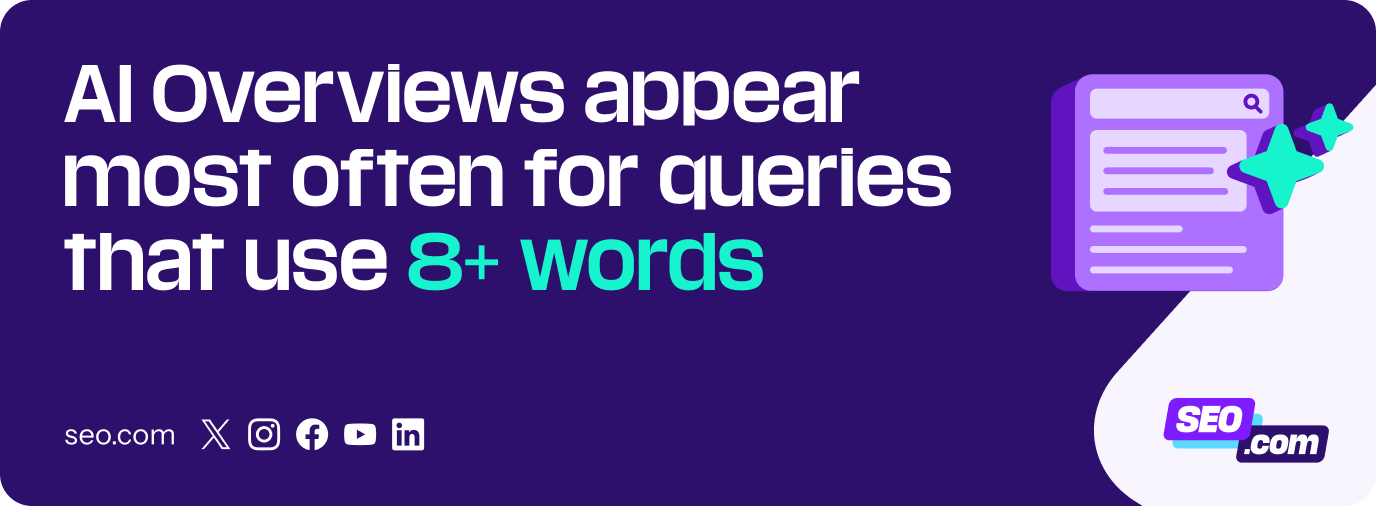
Here’s the breakdown across our 2.3 million keyword sample:
| Words in query | Share of dataset | AI Overview rate | Example |
| 1-2 words | 21.4% | 17.8% | “Dog training” |
| 3-4 words | 56.7% | 23.5% | “best dog trainer” |
| 5-6 words | 18.5% | 32.9% | “how to train my dog” |
| 7 words | 4.4% | 46.2% | “average cost to hire a dog trainer” |
| 8+ words | 3.4% | 57.3% | “how to find the best dog trainer for my dog” |
What this means for your business
It boils down to this — the longer the query is, the higher the chance of AI Overviews appearing.
SEOs have long preached about targeting long-tail keywords as part of a successful SEO strategy, and that still holds true. At the same time, you still may see a decline from long-tail searches (even if you’re ranking well) because there’s a higher probability of AI Overviews appearing in those searches.
So, if you optimize these pages to rank for AI Overviews, you may have a better opportunity to rank higher than before. That will lead to increased brand exposure, but a potential decrease in clicks if an AI Overview is appearing in the results.
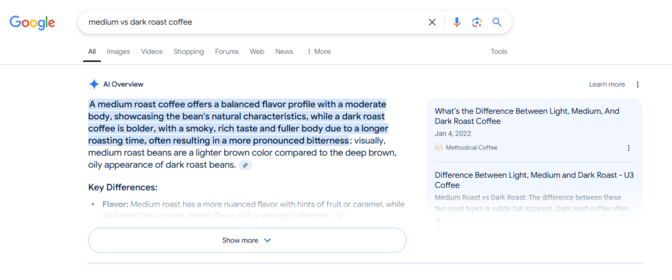
An example of an AI Overview for a search on “medium vs. dark roast coffee”
This increased brand exposure through AI Overviews can lead to follow up searches for your brand that drive traffic directly to your business.
Motivation is key: What types of queries spark AI Overviews?
When you think about AI Overviews, you may wonder if it’s all random. Does Google’s algorithm really have a plan for when to show AI Overviews? Well, yes, and it starts with the searchers’ motivation.
Google mainly delivers AI Overviews to queries where the user’s motivation is to gather information, rather than when looking to buy or navigate to a specific site.
Here’s the breakdown of the data:
| Search Intent | AI Overview appearance rate (All length queries) | AI Overview appearance rate (8+ word queries) |
| Informational | 38.7% | 67.2% |
| Commercial | 21.3% | 44.8% |
| Transactional | 15.8% | 30.4% |
| Navigational | 11.4% | 22.0% |
For all length queries, AI Overviews are less likely to appear in transactional or navigational queries. The number does increase, though, when the keyword length is 8 or more words.
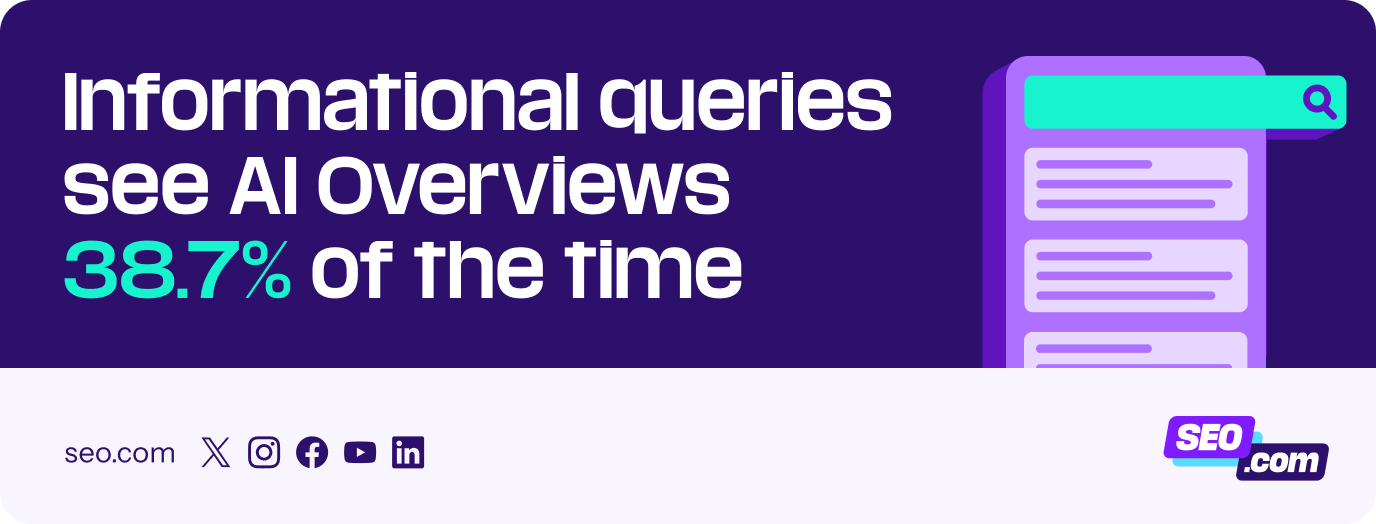
What this means for your business
You need to take AI Overviews into account for all query types, but especially informational ones. Informational queries draw AI Overviews the most, so your blogs, informational articles, and other top-of-the-funnel content need to account for and optimize for appearing in AI Overviews.
Keep in mind, too, that if your SEO success is hinging on a couple of commercial or transactional keywords that could have an AI Overview taking away traffic, it could hurt your yearly goals. It’s important to monitor those keywords to see if AI Overviews appear, so you can adapt accordingly.
The heavy-hitters: What industries are impacted by AI Overviews the most?
Nearly every industry is impacted by AI Overviews, but some are taking a bigger hit than others. The reality is, depending upon what type of queries are your money-makers, you may be effected more than other industries.
If you rely heavily on informational queries to drive revenue, AI Overviews will hit you harder than an industry that relies more on transactional queries to drive revenue.
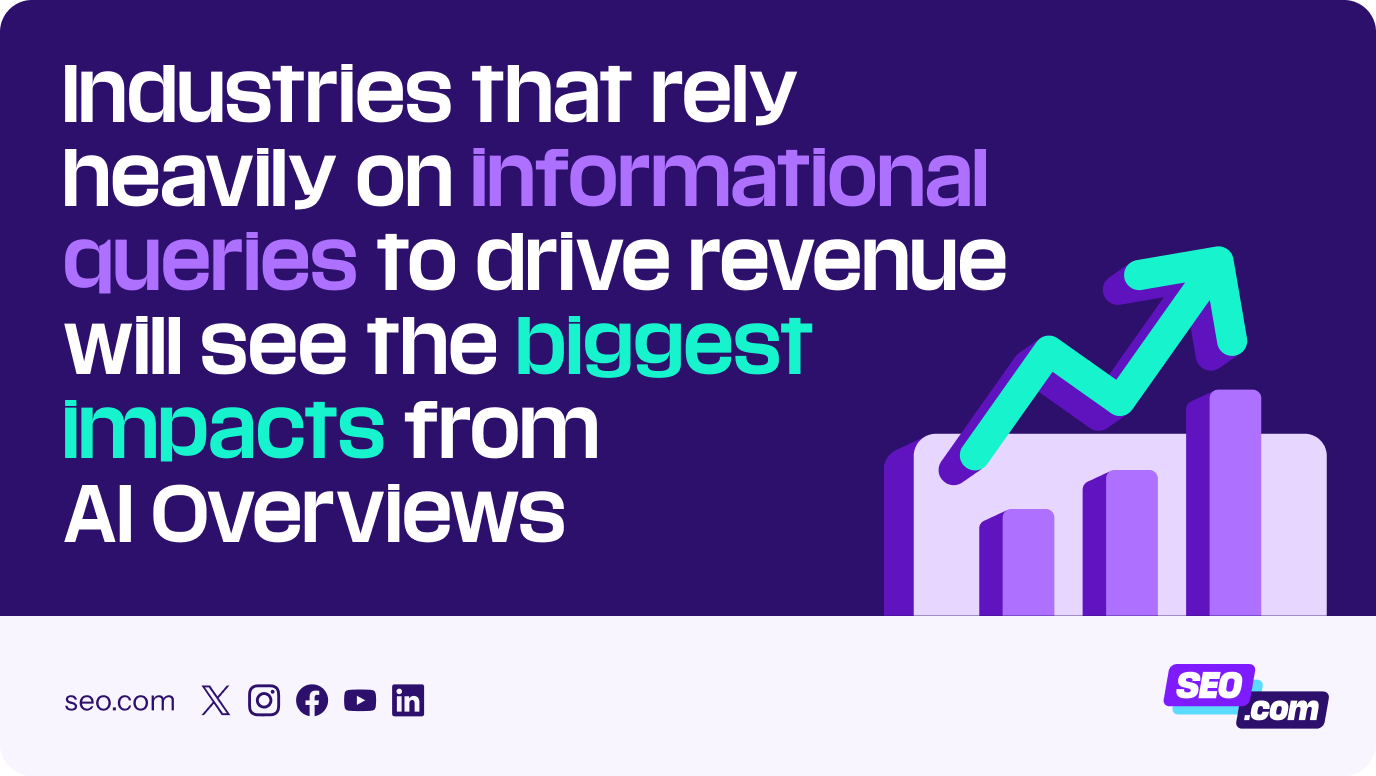
So, which industries will take the biggest hit? Here’s what our data found:
| Industry | AI Overview appearance rate | Level of likelihood |
| Pets & Animals | 45.2% | High |
| Travel Guides | 37.1% | High |
| Crafts & DIY | 34.6% | High |
| Mental Health | 33.9% | High |
| Personal finance | 32.8% | High |
| Sporting Goods | 14.2% | Low |
| Apparel | 11.9% | Low |
| Real-time Tickets & Events | 11.5% | Low |
What this means for your business
If your industry is heavily impacted by AI Overviews like the ones above, you’ll want to start adapting your strategy now to accommodate for less traffic and clicks. But what can you do if you rely heavily on informational queries to drive revenue?
Here are a few suggestions:
- Offer high-value assets: Generative AI can’t replicate things like calculators or diagnostic tools. Offering these unique tools can help you offer value that searchers can’t get anywhere else (like the AI Overviews).
- Leverage original research and data: AI can’t create original research or data. Offering this will help you stand out from your competition and the AI Overviews.
- Gate premium content: If you have high-value assets that can’t be found across the web, like reports or templates, gate them. AI can’t crawl gated resources, so that means users can only access the information by visiting your website and providing their email in exchange.
It’s all about location: How are local queries impacted by AI?
With all this talk about AI Overviews influencing informational queries, it might leave you wondering: What about local searches?
Local searches are unique in their own way — they involve using location-based keywords or “near me” to help searchers find businesses and products in their area. With many other types of search seeing the impact of AI Overviews, you might think it’s impacting local search too.
The reality? AI Overview appearances drop for local searches.
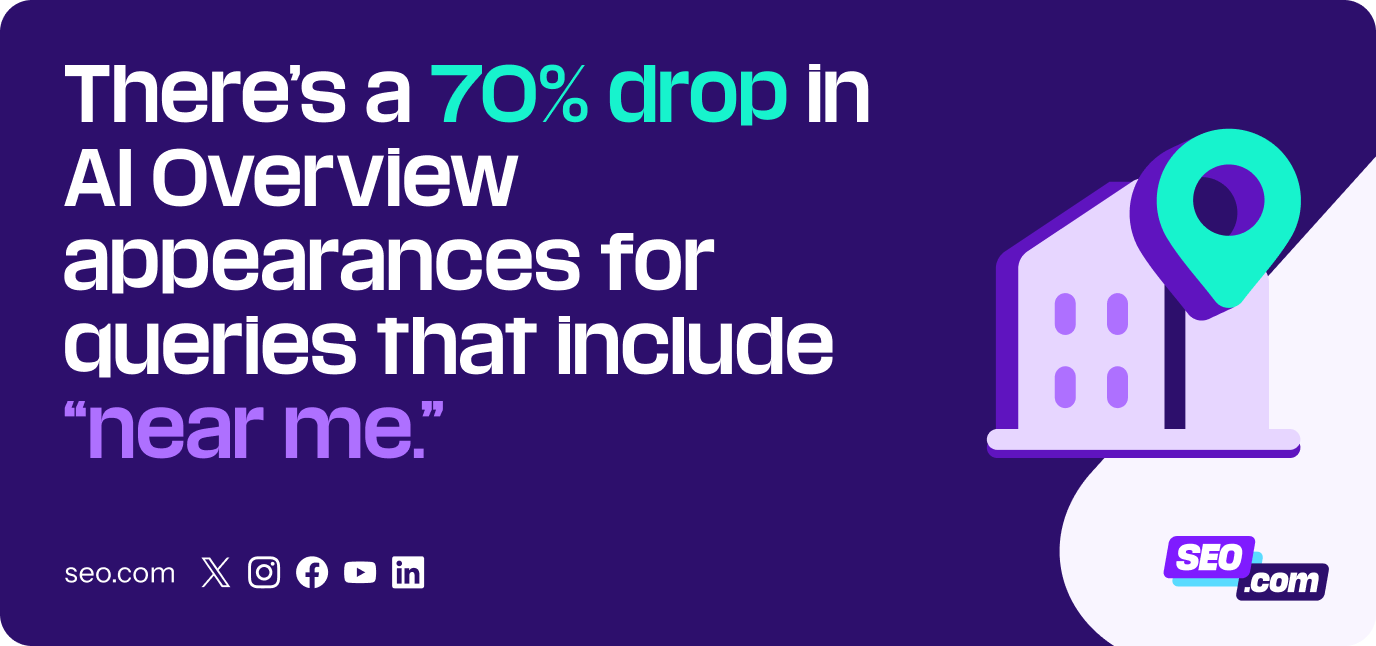
In fact, our data found there’s about a 70% drop (from 35% to 10%) in AI Overview appearances for queries that include “near me.” While there’s still a possibility of AI Overviews appearing, it’s not prominent at this time.
What this means for your business
Now is the time to get your local SEO strategy solidified, especially if you’re in an industry that’s high risk for AI Overviews appearing for other queries (healthcare and finance, for example). Local SEO will be extremely important for driving qualified traffic for your business.
Plus, if Google starts to show more AI Overviews in local queries, having an optimized strategy (which includes adding local structured data) will put your business at an advantage to appear in those Overviews if and when they come.
Asking the right questions: What question queries produce AI Overviews?
When people conduct queries, they’re often using question words like “why” or “how.” So, are there certain question words more likely to produce AI Overviews than others?
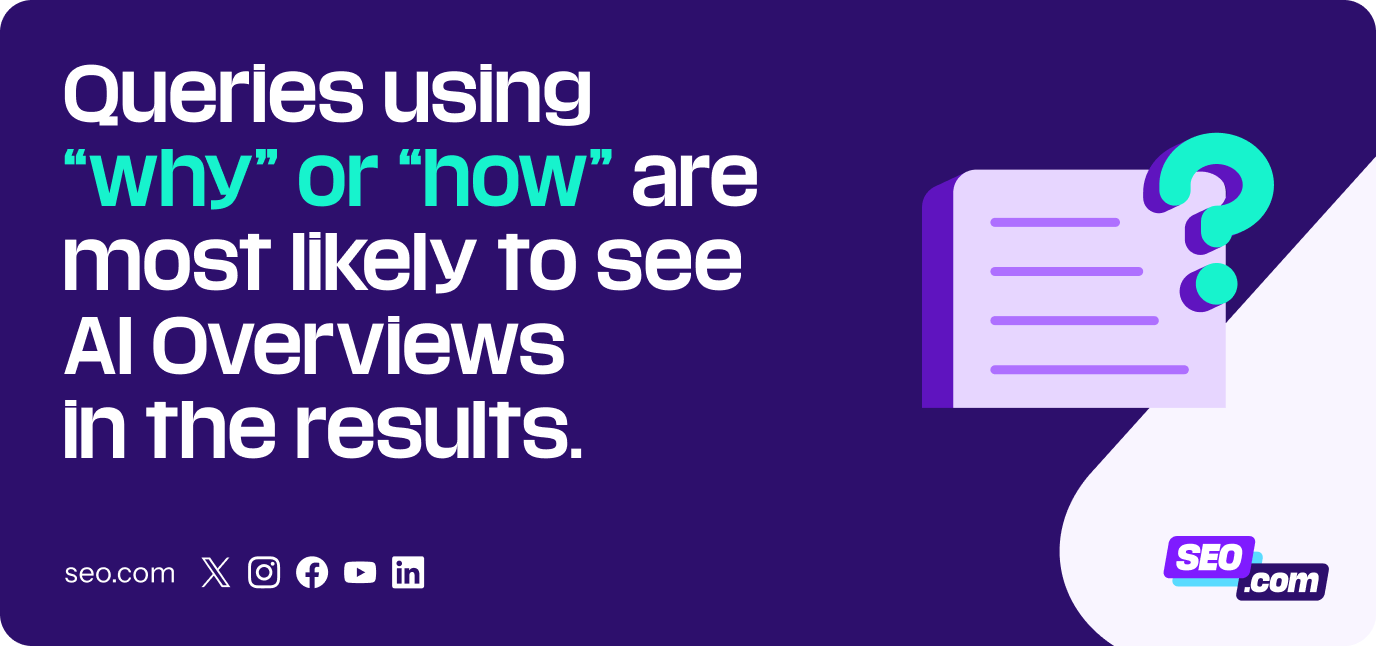
After analyzing 2.3 million queries, our data says yes. Here’s what we found:
| Question word | Example | Average query length | AI Overview appearance rate |
| Why | “Why does my car make a sputtering sound?” | 8.2 words | 41.3% |
| How | “How to repair a broken fence” | 7.5 words | 38.1% |
| Can/Could/Do | “Can roof shingles be painted?” | 6.9 words | 29.4% |
| What | “What is a skid steer loader?” | 6.1 words | 24.7% |
| When | “When can you eat after getting a filling?” | 6.3 words | 23.9% |
| Where | “Where is the best sushi restaurant?” | 5.8 words | 18.6% |
| Brand-first | “Target return policy without receipt” | 4.3 words | 8.7% |
As the data shows, queries that use “why” or “how” are most likely to see AI Overviews in the results. Queries that include “where” or the brand name first are less likely to see AI Overviews in the results.
Here’s a breakdown of the query types and the likelihood of AI Overviews appearing:
| Likelihood level | Types of content |
| High | “Why” explainer content
“How-to” guides/tutorials Deep informational content targeting explanatory queries |
| Moderate | “What” definitional content
“Can/Could/Do” capability queries |
| Low | “Where” location-based content
Brand-first content “When” timing content |
What this means for your business
If you’re targeting a lot of question-based keywords, you’ll want to ensure that your search strategy accounts for AI Overviews. There’s a high likelihood that AI Overviews will appear for many of these question-based queries.
Here’s a breakdown of how to approach your content and keyword targeting, for each likelihood level:
- High: For question queries in the High likelihood level category, you’ll want to ensure you optimize your content for AI Overviews. Since there’s a strong likelihood that one will appear, optimizing for it increases your chances of appearing in it (and at the top of search as a result).
- Moderate: Most content at the moderate likelihood level is definition-based or capability-based (ex. “What is a 401K?” or “Do you get taxed on money in a Roth IRA?”). The best solution is to answer these queries directly, so if an AI Overview appears, you have a better chance of appearing in it by providing a succinct answer.
- Low: Content that targets “where,” “when,” and brand-first keywords are at lower likelihood for AI Overviews appearing, likely because these are mainly transactional and navigational queries that see fewer Overviews. You can still ensure your content is optimized for it by integrating structured data and improving readability.
It’s not just organic: The relationship between AI Overviews and Google Ads
After analyzing all 2.3 million keywords, we found some interesting insights about AI Overviews and Google Ads. You may wonder — are AI Overviews appearing more or less when ads are in the search results?
Here’s what we found:
| Text ad count in SERP | Share of dataset | AI Overview rate |
| 0 ads | 44.2% | 33.2% |
| 1 top-of-page ad | 24.3% | 24.7% |
| 2+ ads (top + bottom) | 17.1% | 17.5% |
| Shopping carousel + ≥1 ad | 14.4% | 9.4% |
So, what does this data mean?
- Google is more likely to show AI Overviews when there aren’t any paid ads in the search results. The AI Overview appearance rate drops about 25% just when one ad appears in the results.
- Shopping queries are less likely to see AI Overviews. So if you’re running Google Shopping Ads, you won’t see AI Overviews very often.
The relationship between CPC and AI Overviews
Now that you’ve seen the relationship between CPC and AI Overviews, you may be wondering if AI Overviews and CPC have any sort of impact on each other.
Our data suggests no — the correlation between CPC and whether AI Overviews appear in search results is not statistically significant enough to warrant any conclusions. So, your cost-per-click amount doesn’t serve as an indication whether AI Overviews are likely to appear.
Instead of focusing on CPC, focus on the correlation between the intent of your keywords and if an AI Overview appears.
Here’s some data on the correlation of AI Overviews based on the intent type:
| Intent Type | Correlation with AI Overview appearing | What it means |
| Commercial | -0.050 | Commercial-intent keywords are not likely to trigger AI Overviews |
| Transactional | -0.087 | Transactional-intent keywords are less likely to show AI Overviews |
| Navigational | -0.159 | Navigational queries are less likely to have AI Overviews appear |
| Informational | +0.241 | Informational queries are more likely to have AI Overviews appear |
So, as you can see, AI Overviews are most likely to appear for informational queries and less likely to appear for navigational, transactional, or commercial queries. That means if you’re running ads for these searches, you won’t have to compete with AI Overviews at the top.
What this means for your business
As of now, AI Overviews are less likely to appear in results where you’re running ads because most of those queries are transactional, navigational, or commercial. You likely only need to worry about AI Overviews appearing if you’re running ads for informational queries to, say, promote blog content or a high-value research piece you’ve done recently.
Takeaways: What this data means for the future of SEO
So, after looking through all this data on AI Overviews, what does it really mean for the future of SEO?
Here are some things the data conclusively showed:
- For right now, AI Overviews appearing seems dependent mostly on user intent.
- The more long-tail and informational the query, the more likely an AI Overview will appear.
- Transactional and navigational queries are more likely to stick to the traditional appearance of search results and less likely to have AI Overviews
- Most local queries will avoid having AI Overviews
- Industries that rely on informational queries for revenue will see greater traffic and click declines than those that rely on transactional queries for revenue
So, what does this mean for the future of SEO? Here are a few key takeaways:
- If AI Overviews are hurting your SEO strategy, PPC may be a viable option to help diversify your marketing efforts. It can help you recapture high-value traffic, so you can continue driving revenue.
- If your SEO strategy hasn’t been up to par, there’s still opportunities for you to optimize it and leverage is into a brand awareness and lead generation channel. AI Overviews aren’t appearing for all informational queries, so there’s still room for you to rank for those queries that aren’t seeing AI Overviews.
- If you have a solid SEO strategy in place, now is the time to prepare for AI Overview adoption. It’s not going away anytime soon, so it’s best to start adapting now and get ahead of your competitors that aren’t hesitant to make the leap.
- Get your local SEO strategy prepared. Local SEO relies heavily on structured data, which means it’s ripe for AI influence. Having your local SEO set in place will keep you ahead for whatever changes may come to local search in the future.
At the end of the day, it’s about embracing the opportunities first to stay ahead of your competition. AI Overviews are here to stay and will keep evolving, so it’s best to start adapting for them now, then scrambling to catch up later.
The future is now: Start optimizing your SEO strategy for AI Overviews
AI Overviews aren’t going away anytime soon — if anything, you’re going to start seeing them appear in more queries across the web. While AI Overviews can get information wrong, they’re going to continue getting better and more accurate as time goes on.
That means even more people will turn to these Overviews for the information they need.
Now is the time to prepare your search strategy for these AI Overviews, so you’re primed for success as they become even more integral in search.
Start by checking to see where you’re already appearing in AI Overviews using our free AI Overviews Checker. Using that as a jumping off point to know where you’re already appearing and gain insights into what other pages appear in Overviews.
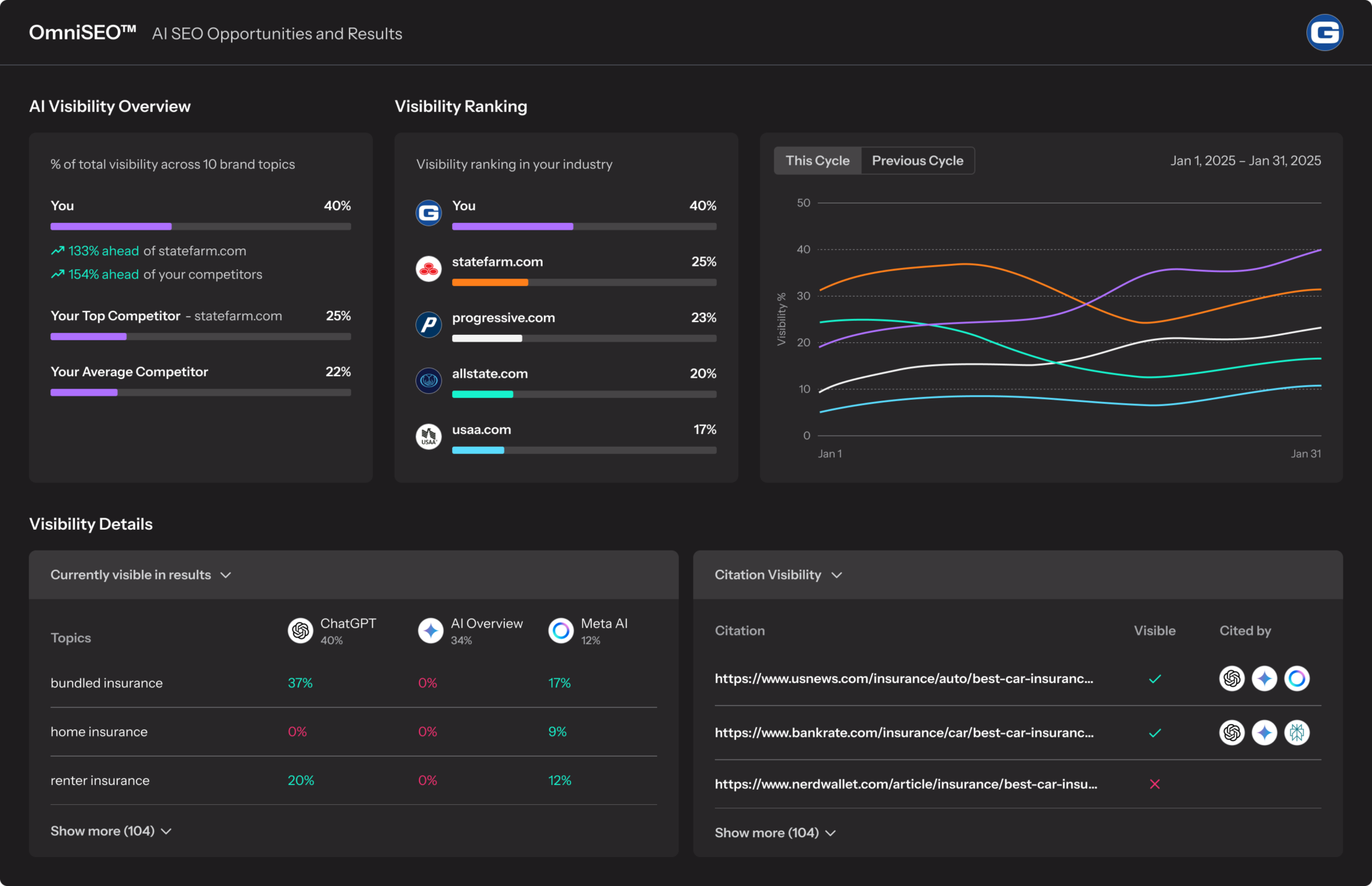 A screenshot of the OmniSEO® dashboard shows AI search visibility
A screenshot of the OmniSEO® dashboard shows AI search visibility
If you’re not feeling confident about tackling optimzing for AI Overviews, we’ve got just the thing for you — OmniSEO® services. Our OmniSEO® services help you optimize your website for AI Overviews and other generative AI engines, like ChatGPT, Claude, and Gemini.
Connect with us today to see how we can help you future-proof your SEO strategy!

Track Rankings Beyond Search
Your prospective customers are searching in AI engines beyond traditional search. Are you ranking?


Table of Contents
- The Long Road Home: Where Do AI Overviews Mainly Appear?
- Motivation is Key: What Types of Queries Spark AI Overviews?
- The Heavy-hitters: What Industries Are Impacted by AI Overviews the Most?
- It’s All About Location: How Are Local Queries Impacted by AI?
- Asking the Right Questions: What Question Queries Produce AI Overviews?
- It’s Not Just Organic: the Relationship Between AI Overviews and Google Ads
- The Relationship Between CPC and AI Overviews
- Takeaways: What This Data Means for the Future of SEO
- The Future is Now: Start Optimizing Your SEO Strategy for AI Overviews

Future-Proof Your SEO Strategy with OmniSEO®
Goodbye search engine optimization, hello search everywhere optimization.
Writers






